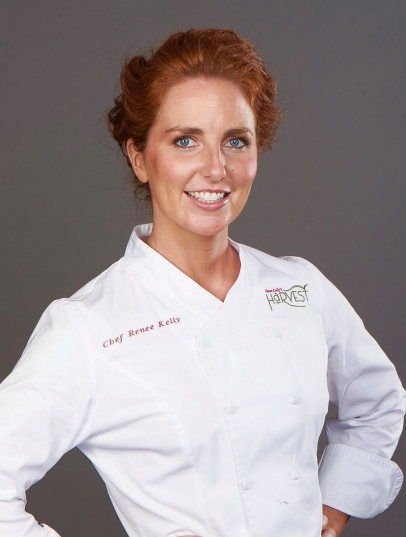The Power of Eating Local
Chef Renée Kelly talks about changing the food landscape, one plate at a time.
It’s common these days to hear professional chefs talk about cooking to the rhythm of the seasons. About taking whatever the earth yields at the moment and transforming it into memorable dishes, about embracing a region’s indigenous produce and making it the star.
Renée Kelly, chef-owner of Harvest in Shawnee, Kansas, is no exception. Kelly embraces sustainability in all its rooted glory, hugging it, twirling it up in the air like a pizza crust and letting it land in its natural state.
Kelly wants customers to think of her as their surrogate farmer—someone who is a steward of fresh, plucked-from-the-soil-this-morning produce. The fiery, redheaded chef who regularly sports a thick red braid is something of a pied piper when it comes to eating locally grown foods and collaborating with growers to embrace Mother Nature’s bounty. She lives for the challenge of riding the roller-coaster of seasons in this neck of the woods to nourish people, to make them happy, to fill their bellies with goodness.
“It’s my job, to pay heed to the seasons,” Kelly says. “Eating honestly, feeling good after you eat, only helps us to be better people.”
After a busy morning of turning out Sunday brunch to the faithful at her castle-turned-restaurant in the sleepy suburb of Shawnee, Kelly stops for a nanosecond to talk about what—and who—inspires her culinary point-of-view. And, as a bonus, Kelly works a little math problem that brings the conversation about sustainability full circle.
KS: Go back to the beginning—who is your biggest culinary influence?
RK: Hands down my mom, Nancy Neighbor. She always let me cook with her and taught me to create through smell. Even today, when we cook together, she says things like, “It smells like it needs more oregano.” I learned to smell in color, taste in shapes, cook with sound because of her—think sensory alteration. I remember making meatballs with her—she wanted me to recognize different smells. It didn’t register with her that it was the layer concept.
KS: What jumpstarts your creativity in the kitchen?
RK: The weather, seasons, patterns that lie within food, smells, my dreams, singing, dancing. All food should sing and dance on a plate, don’t you think?
KS: What’s your biggest culinary asset?
RK: Besides my team and the farmers, growers, and producers? My intuition. I’ve learned to trust it when it comes to cooking.
KS: As a Kansas chef, what benefits do you have that many others across the country don’t?
RK: The luxury of having seasons. Some people think it is difficult, but in reality, it’s very simple. For example, we don’t have blackberries but for a month or two. When they are in season, they are the very best anyone can get their hands on. We get to experience everything at its peak. Also, Kansans are rooted, grounded people, which helps keep life with food clear.
KS: What are you looking forward to cooking with/creating this spring?
RK: Ahhh–spring is the broom for our systems. Dandelion sauces, Swiss chard dumplings, radish salad with mint, spring garlic dressing over petite kale. I love to brighten fish and chicken dishes with the lemony attributes of sorrel.
KS: Where do you eat after hours in Kansas City?
RK: I usually go eat at my friends’ places, to support them. I love to be comfortable where I eat. Plus most of my friends know all my food allergies and they will be happy to prepare something. Bryan Aaron at Tannin Wine Bar rocks everything he does—his food is straightforward, and balanced. Plus he gives really good hugs. Charles d’Ablaing at Chaz on the Plaza is brilliant. His flavor profiles are spot on and he always works with familiar food, but gives it his own touch. I like that the restaurant on The Raphael’s lower level is quaint and cozy. Matt Arnold at Webster House always has tasty food done right. I love sitting at the chef ’s table, where I feel very comfortable among the nuances of chaos. Michael Foust at The Farmhouse is authentic and so is his food. He does classic cooking and supports traditional food while still keeping an eye open to new seasonal flavors. Jason Wiggins at the InterContinental has opened my eyes to sustainable product across the country. Other places I’ve got to have: Blue Koi’s dumplings and soups and Hot Basil’s pineapple fried rice.
KS: Why do you think KC is such a collaborative culinary community?
RK: We are real, down-to-earth people who actually talk with each other and enjoy one another. The farmers share names, and so do the chefs. Transparency gets everyone far in Kansas City.
KS: What staples do you stock in your home fridge?
RK: Besides butter? Homemade chicken stock, capers, olives, and fig jam.
KS: So you have a simple math equation on the choices we have, every day, to eat local.
RK: Think about it—we all have the power to change how we eat and what we eat. It’s a generational movement. There are 365 days in the year, and we eat, on average with meals and snacks, five times a day. That’s 1,825 times during the calendar year we can make good decisions.
For more information on Chef Renee Kelly: ReneeKellysHarvest.com.






